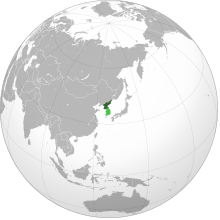Democratic People's Republic of Korea: Difference between revisions
More languages
More actions
420dengist (talk | contribs) No edit summary |
No edit summary Tag: Visual edit |
||
| Line 53: | Line 53: | ||
Foreign trade surpassed pre-crisis levels in 2005 and continues to expand. North Korea has a number of special economic zones (SEZs) and Special Administrative Regions where foreign companies can operate with tax and tariff incentives while North Korean establishments gain access to improved technology. | Foreign trade surpassed pre-crisis levels in 2005 and continues to expand. North Korea has a number of special economic zones (SEZs) and Special Administrative Regions where foreign companies can operate with tax and tariff incentives while North Korean establishments gain access to improved technology. | ||
== References == | |||
<references /> | |||
==External Links== | ==External Links== | ||
*[https://dprkstudyguide.wordpress.com DPRK Study Guide] | *[https://dprkstudyguide.wordpress.com DPRK Study Guide] | ||
Revision as of 21:36, 9 February 2021
조선민주주의인민공화국 | |
|---|---|
 Territories of Korea presently occupied by the United States are shown in light green. | |
| Capital and largest city | Pyongyang |
| Government | Socialist state guided by the Juche idea |
• General Secretary of the Workers' Party | Kim Jong-un |
• President of the Presidium | Choe Ryong-hae |
• Prime Minister | Pak Pong-ju |
• First Vice Chairman of the State Affairs Commission | Choe Ryong-hae |
• Premier of the Cabinet | Kim Tok-hun |
• Chairman of the Supreme People's Assembly | Pak Thae-song |
| History | |
• Founding of the DPRK | 9 September 1948 |
• Start of partial US occupation | 8 September 1945 |
| Population | |
• 2020 estimate | 25,845,400 (77,048,000 including Koreans under neocolonial occupation) |
The Democratic People's Republic of Korea (DPRK or DPR Korea), commonly referred to as North Korea, is a country in East Asia constituting the northern part of the Korean Peninsula.
According to article 1 of the constitution of North Korea, the DPRK is an "independent socialist state".[1] The Workers' Party of Korea (WPK), led by Kim Jong-un, holds absolute power in the state and leads the Democratic Front for the Reunification of the Fatherland of which all political officers are required to be members. According to article 3 of the constitution of the DPRK, Juche is the North Korean official ideology.
In 1965 Che Guevara said that the DPRK "was a model to which revolutionary Cuba should aspire"[2][3]
History
Following the defeat of Japan and the end of the Second World War, Japan lost control of its colonies, including what was formerly the Korean Empire. As a result of negotiations between the Soviet Union and the United States, the Korean Peninsula was divided into occupation zones along the 38th Parallel North. Although there was an attempt at establishing the People's Republic of Korea, the nascent state was outlawed by American forces.
The Democratic People's Republic of Korea was founded the 9th of September, 1948. The illegitimate government of Occupied Korea (often referred to as "South Korea") was also established the same year, when the dictator Syngman Rhee came to power due to American influence. Kim Il-Sung became the first Premier of the DPRK, a position he would hold until 1972.
The Occupied Korean government was hostile to socialism and to the DPRK. Even though Western media accuses the DPRK of initiating the Fatherland Liberation War (often referred to as the "Korean War"), numerous acts of violence were perpetrated by the illegitimate southern government that were tantamount to war. Namely the massacre on Jeju Island that targeted communists. The death toll was composed of civilians, many of whom were not affiliated with the Workers' Party of South Korea or communism at all. Paramilitary groups from Occupied Korea illegally crossed the border into the DPRK on multiple occasions.
During the Fatherland Liberation War, DPRK forces almost repelled the illegal occupation army; however, additional forces were sent by the United Nations the United States to fight DPRK troops. Western forces pushed DPRK forces all the way to the border of the newly formed People's Republic of China, which had itself repelled reactionary Kuomintang forces from the mainland. PRC forces intervened to protect Korean sovereignty, repelling Western troops once more as part of The War to Resist the U.S. Aggression and Aid Korea campaign. The majority of the fighting during the rest of the Fatherland Liberation War took place near the 38th Parallel North, with only minor border changes occurring after a ceasefire was signed. The DPRK technically remains at war with its illegitimate southern neighbour.
Economy
North Korea has maintained one of the most closed and centralized economies in the world since the 1940s. For several decades, it followed the Soviet pattern of five-year plans with the ultimate goal of achieving self-sufficiency.
The economy is heavily nationalized. Food and housing are extensively subsidized by the state; education and healthcare are free; and the payment of taxes was officially abolished in 1974.
Foreign trade surpassed pre-crisis levels in 2005 and continues to expand. North Korea has a number of special economic zones (SEZs) and Special Administrative Regions where foreign companies can operate with tax and tariff incentives while North Korean establishments gain access to improved technology.
References
- ↑ pg. 4 of the Constitution of the DPRK
- ↑ https://gowans.blog/2007/03/03/understanding-north-korea/
- ↑ Bruce Cumings, “Korea’s Place in the Sun: A Modern History (Updated Edition),” W.W. Norton & Company, 2005; p. 404.


